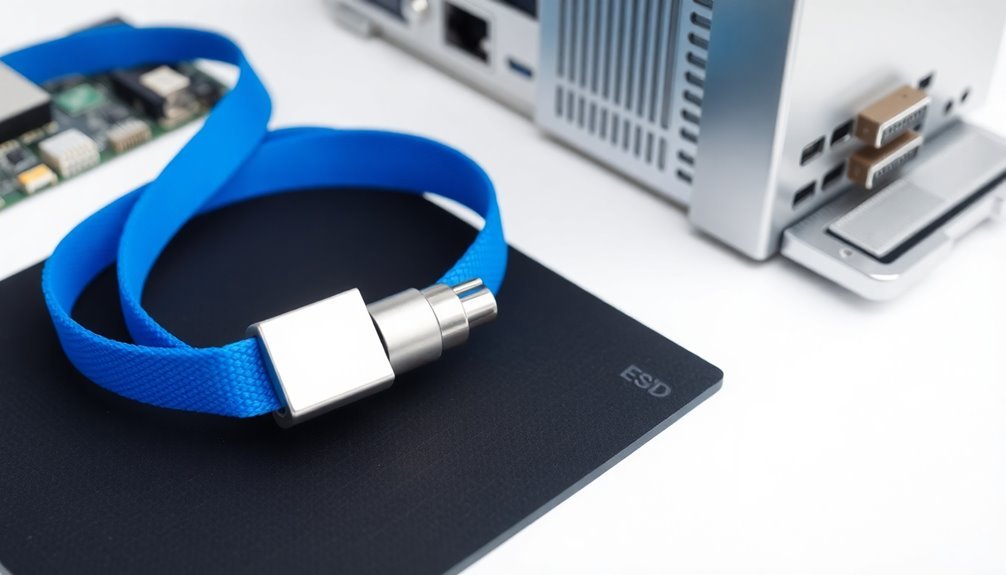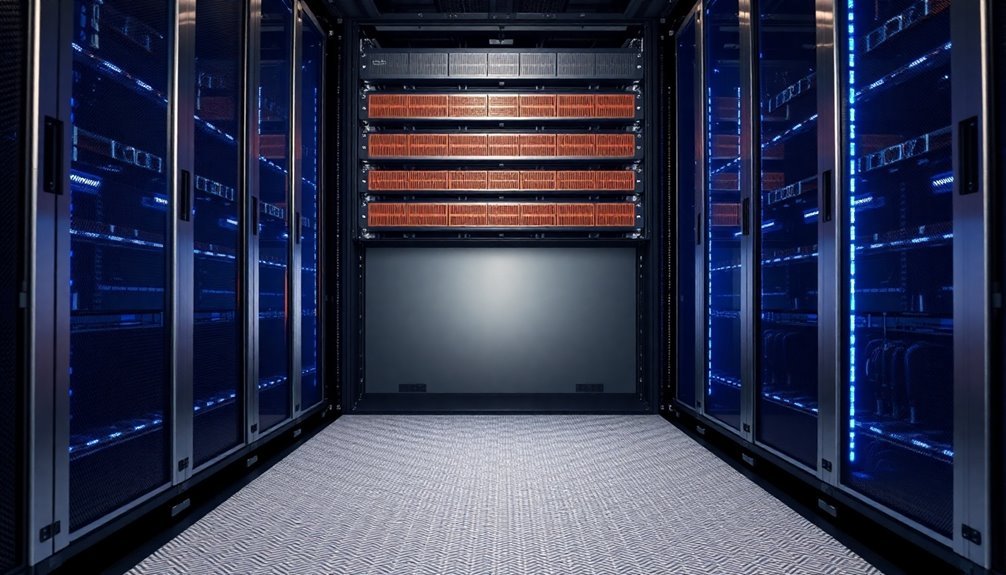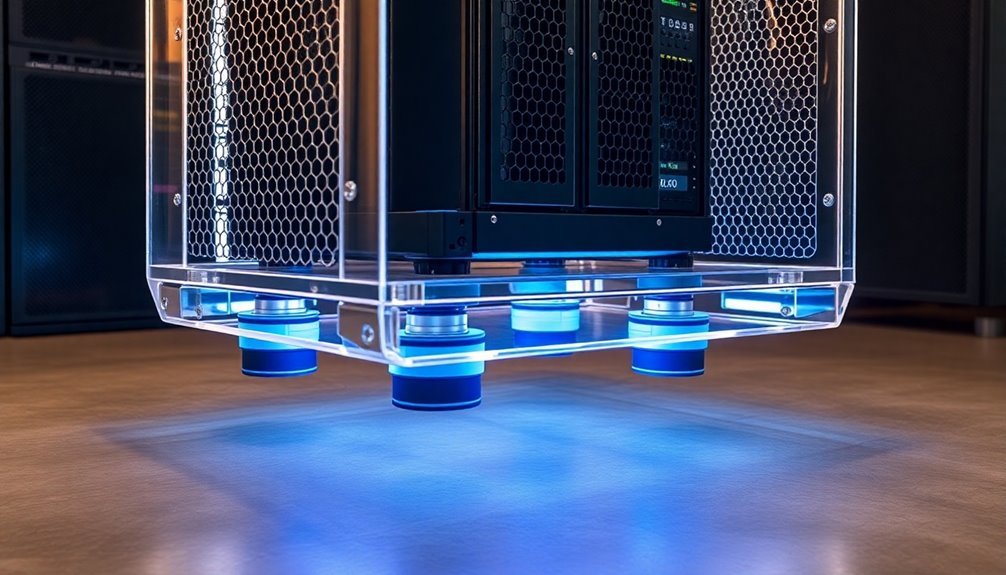You'll need three essential anti-static tools to protect your sensitive server equipment from damaging electrostatic discharge (ESD). First, wear a grounding wrist strap with a built-in 1 megohm resistor that connects you safely to ground. Next, use a carbon-fiber static control mat as your work surface to dissipate static charges. Finally, install an ionizing air system to neutralize static electricity in your workspace environment. When used together properly, these tools create a thorough ESD protection system that can save you thousands in equipment damage. Let's explore how to implement these vital safeguards effectively.
Grounding Wrist Straps

Three essential components make up a grounding wrist strap system: a conductive wristband, a coil cord, and a ground connection point. When you're working with sensitive server components, this system prevents static electricity build-up by keeping you at the same electrical potential as grounded objects.
You'll find two main types of wristbands: elastic and metal. Elastic bands offer adjustability and comfort, while metal versions last longer and are easier to clean. Both types use conductive materials like carbon or carbon-filled rubber to guarantee proper grounding. For sensitive skin concerns, hypo-allergenic fabric options are available as alternatives.
Before each use, you'll need to test your wrist strap to confirm it's functioning correctly. The system should maintain a total resistance to ground of no more than 35 megohms, complying with ANSI/ESD S20.20 standards.
Don't worry about electrical shock – there's a built-in one-megohm resistor for your protection.
If you're working regularly with servers, consider using continuous monitors that provide instant feedback on your wrist strap's performance. Remember not to wear the strap when working with circuits exceeding 250 volts, and guarantee proper skin contact to maintain effective grounding.
Carbon-Fiber Static Control Mats
Carbon-fiber static control mats serve as your first line of defense against electrostatic discharge in server environments. These specialized mats contain embedded carbon fibers that effectively dissipate static electricity, protecting your sensitive electronic components from potential damage.
You'll find these mats available in various forms, including chopped carbon fiber (2-6mm) and milled carbon fiber (0.13-2mm) variations. While milled fiber allows for thinner mats, you might notice some aesthetic differences.
For server rooms and data centers, you'll want to focus on self-leveling flooring options that provide thorough protection across your facility. With same-day shipping available for most orders, you can quickly address any static control needs.
To maintain peak performance, you'll need to guarantee proper grounding of your mats. Regular conductivity testing helps verify they're working effectively.
When installing these mats in your server room, consider both floor and workstation applications to create a complete static-free environment.
You don't need to worry about humidity affecting your mat's performance, as they're designed to maintain consistent effectiveness under varying conditions.
Remember to clean and inspect your mats regularly to maintain their static-dissipative properties.
For high-sensitivity environments like IDF rooms, you'll want to select higher-performance options with enhanced static control capabilities.
Ionizing Air Systems

While static control mats provide ground-level protection, ionizing air systems offer active defense against static electricity throughout your server space. These systems work by producing positive and negative ions that neutralize static charges on surfaces, making them essential for protecting sensitive server components. Regular maintenance every 6 months helps ensure optimal ionizer performance and reliability.
You'll find both corona (electrical) and alpha (non-electrical) types available, with benchtop and overhead options to suit your specific setup.
When you're working with servers, you'll want to position your ionizers strategically to guarantee effective ion distribution. Overhead ionizers are particularly useful as they eliminate the problem of blocked airflow that can occur with benchtop units.
For targeted static elimination, compressed air ionizers deliver a powerful blast that both neutralizes charges and removes contamination.
Key benefits of implementing ionizing air systems:
- Meets ISO S20.20 ESD compliance requirements for professional server environments
- Provides safe static neutralization without chemical sprays
- Works effectively on non-conductive materials that can't be grounded
- Offers flexible deployment options for different workspace configurations
- Maintains zero ozone emissions when UL 2998 certified.
Frequently Asked Questions
Can Smart Anti-Shock Tools Integrate With Existing Server Monitoring Systems?
You'll find that modern monitoring systems readily integrate with existing server setups, offering extensive compatibility, multi-vendor support, and agentless monitoring capabilities across platforms like SolarWinds SAM and PRTG Network Monitor.
What Temperature Ranges Are Optimal for Anti-Shock Tool Performance?
You'll want to maintain temperatures between 68°F and 71°F for ideal performance, as this range helps prevent thermal stress. Don't let it exceed 80°F, as this can compromise both tool and server functionality.
How Often Should Smart Anti-Shock Sensors Be Calibrated?
You'll need to calibrate your anti-shock sensors annually, but check them quarterly for accuracy. If you're in harsh environments or notice performance issues, you should calibrate them more frequently for optimum results.
Do Anti-Shock Protection Systems Work During Power Outages?
Yes, your anti-shock protection systems will work during power outages. They'll provide temporary backup power through UPS systems, allowing your servers to shut down safely and protect against data loss and hardware damage.
Can These Tools Predict Potential Shock Events Before They Occur?
Yes, you'll find these tools can predict potential shocks through real-time monitoring, data analysis, and machine learning models. They'll alert you to warning signs and help prevent damage before incidents occur.
In Summary
By using these three essential anti-shock tools, you'll substantially reduce the risk of damaging your servers through electrostatic discharge. You won't regret investing in a grounding wrist strap, carbon-fiber static control mat, and ionizing air system. They'll protect your valuable equipment and help you avoid costly repairs or replacements. Remember, it's much cheaper to prevent static damage than to fix it.





Leave a Reply